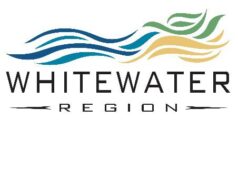WHITEWATER REGION (Cobden) — There are approximately 24 years remaining before the Ross Landfill site is full. Last week, the Environmental Services Committee presented the report for information purposes to the Council of the Township of Whitewater Region in regards to the remaining capacity at the Ross Landfill site.
Throughout budget deliberations, with particular reference to the landfill site and subsequent operational changes to waste management programs, both “compaction” and “airspace” were broadly discussed. According to Janet Collins, asset management coordinator, staff have received emails regarding these concepts and are providing general information to assist Council, staff and members of the public. “The 2019 annual landfill site report is due March 31, 2020; however preliminary quantities indicate a volume of 8,550m3 in 2019,” said Mrs. Collins.
Landfill airspace is defined as the volume available within a designated area for waste. It is also defined as Landfill Capacity, which is the amount of available airspace volume a site has for disposal. The remaining capacity is based on the rate of materials being disposed compared to the remaining airspace available for disposal in a landfill.
Mrs. Collins stated waste compaction includes both pre-landfill compaction and landfill compaction. She said Whitewater Region undertakes pre-landfill compaction by collection. The contractor utilizes, in most cases, a compaction truck. “Compaction allows more
waste to fit in the same space,” she said. This means fewer trips to the landfill site, which reduces collection costs. These costs can include manpower, equipment, and fuel. It also means fewer green house gas emissions and fewer road and equipment wear and tear. There are trash compactors available for both residential and commercial use which would also provide pre-landfill compaction.
The Township documents state landfill compaction takes place at the landfill site itself using a landfill compaction vehicle. It goes on to detail, “this vehicle spreads the waste evenly in layers over the landfill and compacts the waste to reduce its volume and help stabilize the landfill. Proper waste compaction will shred, tear and press together various items in the waste stream so they consume a minimal volume of landfill airspace.”
The higher the compaction rate, the more trash the landfill can receive and store. Mrs. Collins detailed high compaction rates also reduce landslides, cave-in’s and minimizes the risk of explosions of landfill gas. The downside to achieving high compaction rates is the biodegradation of organic waste is slowed due to reduced oxygenation.
The Ross Waste Disposal Site 2018 Annual Report indicates the remaining capacity, based on survey and investigation results on a five year average, equates to approximately 24 years remaining years. The Ross Landfill Site also provides depot services including recycling, brush
separation and grinding. Mrs. Collins said these services use an extensive portion of the “footprint” where waste would be otherwise disposed of. In order to maximize allowable airspace, she said operations will need to be altered. Anomalies like flood debris or significant operational changes, such as removal of organics, can also significantly reduce airspace.
Mrs. Collins went on to detail as organic waste decomposes in a landfill, it produces a gas. This gas is composed primarily of approximately of 40 to 60 per cent methane, while the remainder is mostly carbon dioxide with trace amounts of other volatile organic compounds (VOCs).
She explained methane gas is not “landfill airspace” by definition. Methane gas is a greenhouse gas which contributes to climate change.
Landfill gas can be recovered and utilized which can provide the following benefits: capturing and combusting landfill gas prevents substances like methane from escaping to the atmosphere; and landfill gas can be utilized to generate electricity.
Whitewater Region is not currently undertaking a review to capture landfill gas. The amount of landfill gas generated at a specific landfill is a function of multiple factors, including waste quantity, waste composition, and the amount of time since the waste was disposed. In addition to these factors, there are various common barriers to consider prior to landfill gas recovery including: flawed disposal site design and operation; poorly designed and operated landfill gas collection and control system; difficulties estimating landfill gas volumes available to the project; selecting appropriate energy recovery technologies; and financing the project.






![Kenopic/Smith Auction [Paid Ad]](https://whitewaternews.ca/wp-content/uploads/2018/10/advertising-100x75.jpeg)

